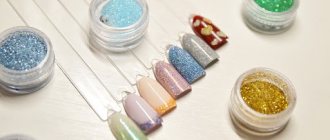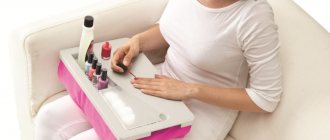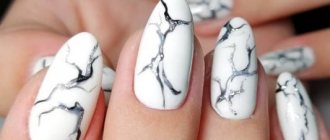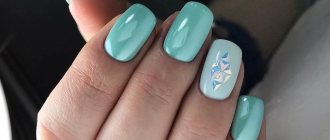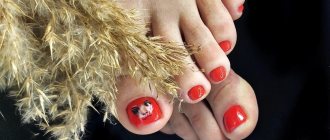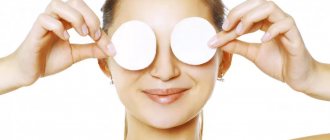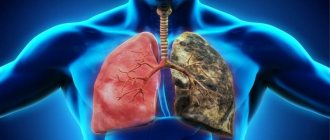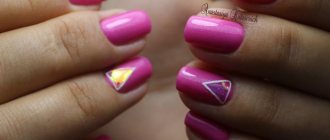You can restore your nails after gel polish using products from the line of professional cosmetics, medicinal varnishes, home remedies, and salon procedures. The most effective is considered to be a combination of pharmaceutical products and masks/baths made from familiar ingredients - the recovery period is reduced to 1 month.
Procedures for restoration and strengthening should be carried out regularly; if full-fledged therapy is required, then consultation and prescriptions from a dermatologist will be required. Experts recommend once every 3-6 months of regular use of gel polish to go to a beauty salon for professional restoration of the plates - lavender massage, Japanese or hot oil manicure.
How to restore nails after gel polish: basic methods
You can restore your nails after gel polish in several different ways:
- Home remedies - we are talking about baths and masks, which should be used daily for 10-15 days. Most often, decoctions of medicinal herbs and masks based on oils and cosmetic clay are used for procedures. You can use paraffin and gelatin at home, but manipulate these products no more than 2 times a week.
Paraffin therapy
Any home remedies will be effective for restoring nails only if they are slightly damaged by gel polish.
- Varnish coating with therapeutic effects . The product contains calcium and vitamins that actively nourish the nail plate, make it stronger, and eliminate splitting and fragility. Nails are covered with this product either daily or 2-3 times a week - it all depends on the specific varnish chosen.

Therapeutic products have a quick effect - after 5-7 days the plates are almost completely restored, and you can use gel polish for manicure again.
- Pharmacy products . They are express methods, applied to damaged nails several times a day, the appearance of the plates returns already on the 3-5th day of the procedure. Pharmacies sell products from a range of professional restorative cosmetics, which are distinguished by their complex composition, hypoallergenicity and high efficiency.

All pharmaceutical products are recommended to be used in conjunction with folk remedies, which will help quickly restore the cuticle and soften the skin of the finger.
Another effective way to restore nails after gel polish is salon procedures, which are equivalent to professional treatment.
We recommend reading the article about the difference between gel polish and shellac. From it you will learn what is the difference between gel polish and shellac, what is better and what is more harmful, and also how to extend the wearing period. And here is more information about how to do a French manicure with gel polish.
Nails after gel polish: what problems can you encounter?
After a manicure with gel polish, you may encounter the following problems:
- nails take on a green or yellow tint;
- severe thinning of the nail plate;
- pain that is felt even at complete rest;
- delamination and fragility of plates;
- fungal diseases;
- surface unevenness.
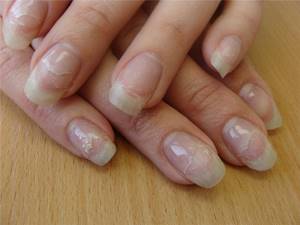
Each problem has individual reasons for its occurrence, and most often the fault falls on the master, although the girls/women themselves are capable of hopelessly damaging the plates, which will then need to be restored for a long time.
Why do my nails hurt after removing the coating?
After removing the coating, your nails may hurt due to the use of low-quality products for this. These contain acetone, which practically burns the thinned nail plate - this causes pain.
The second reason for the appearance of pain after removing the decorative coating is performing this procedure yourself using “improvised” means. In this case, the top layer of the nail plate is removed, which causes discomfort.
The solution to the problems is quite simple:
- To remove gel polish, use only professional cosmetics whose composition is safe;
- Do not remove the decorative coating yourself to avoid damaging the natural nail.

Nail disease
Onycholysis is a nail disease that is often diagnosed after prolonged use of gel polish during manicure.
The essence of the pathology is the detachment of the plate from the nail bed against the background of:
- disturbances of air microcirculation in the nail plate;
- significant deficiency of nutrients and oxygen;
- reducing the amount of enzymes in the nail.
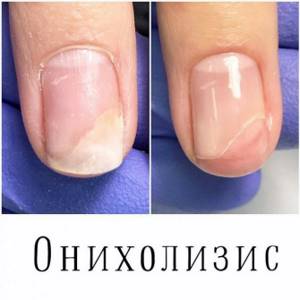
Onycholysis can be of infectious or non-infectious origin; the second variant of the disease is more common.
Reasons for its development:
- using expired or low quality gel polish;
- carrying out manicures with violations;
- excessive compression of the nail plate, its injury with instruments;
- long-term use of gel polish;
- using a non-sterile instrument for the procedure.
Treatment of the disease is carried out on an outpatient basis, for which antiseptic solutions, medicinal/pharmaceuticals, and baths are used. If the nature of the origin of onycholysis is infectious and fungal, then you will need to consult a dermatologist and use antifungal drugs in therapy.
Green nails
Nails may turn green after gel polish due to the use of low-quality coating of bright, saturated colors - the top layer of the nail plate is simply stained.
But often green spots indicate the development of a fungal disease, and it appears when:
- improperly performed manicure using non-sterile instruments;
- wearing gel polish for a long time without interruption;
- penetration of an infectious agent into the site of nail injury.

In case of such a problem, experts recommend abandoning the decorative coating for 2-3 months, cutting off the growing nail and achieving complete restoration of the plate. Doctors, after examinations and clarification of the diagnosis, may prescribe manipulation to completely remove the nail and carry out local therapy.
Thin plate, damaged and soft nails
Too thin a plate, soft, obviously damaged nails - this is not the result of using gel polish as a decorative coating, but the result of improper work by the master. A similar problem arises when the master removes too large a layer of the plate with a special nail file - this was previously required during extensions. This is how this part of the preparation for applying gel polish should go:
- the untouched plate is treated with a fine-grained buff in literally 2-3 movements;
- the master does not press on the plate, but simply “strokes” it.
If you apply an acid primer to an already damaged plate and do not dry it completely, then the next time your fingers stay in the lamp, the nail will burn, which makes it even thinner and softer.
Watch the video on how to do a manicure for damaged nails:
It is impossible to solve such a problem with therapy; you should abandon the decorative coating and wait until the new nail grows completely.
They come off (peel off) and flake off
If the nails peel off, come off in layers (peel off) from the sides and near the cuticle, then the reason for this lies not in the gel polish itself, but in the methods of removing it when replacing the coating. If the procedure involves using a machine, when you manage to leave the top layer of the plate intact, you don’t have to worry: the likelihood of getting peeling nails at the end is low. But removing gel polish with special liquids leads to:
- damage to the top natural layer of the nail;
- overheating of the natural plate while it is in the foil.

The type of primer the master uses during manipulation also plays a big role - if it’s acid-based, then you can expect nails to peel after being in an ultraviolet or LED lamp.
Growths under nails after shellac
Sometimes after shellac, “growths” appear under the nails, which are discovered after the next removal of the decorative coating. They are small tubercles around which voids are clearly visualized. When pressing on the problem areas of the nail, there is no pain, but some discomfort is present.
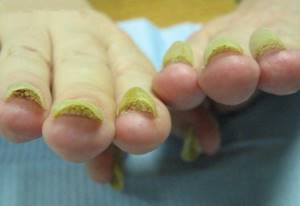
"Growts" under the nails
Most often, such a problem arises against the background of wearing a manicure with gel polish for too long and damaging the natural nail plate (the fact itself can simply happen unnoticed). The solution to the problem is to rest (refuse gel polish/shellac), use masks, baths in hand care for 6-10 months. It is recommended to cut your nails as short as possible to prevent the plate from tearing away from the nail bed.
Uneven nails
Uneven nails are most often the result of unprofessional removal of gel polish using a solvent and a wooden stick (orange). The mistake is inherent in beginners - they first do not completely withstand the time that the cotton pads with the solvent are on the decorative coating, and then they are too zealous in removing it with a stick. There is banal damage to the surface of the nails - partial, which makes it uneven. How to solve a problem:
- refuse to use any decorative coatings;
- use a soft buff to remove pronounced irregularities from the surface of the nail;
- apply medicinal products to nails;
- wait until the healthy plate grows completely.
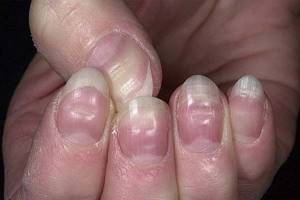
An example of an uneven nail plate
Reasons to start recovery
If all circumstances are successful, any client of a beauty salon or home-grown manicurist will do just fine without restorative procedures. However, it may happen that the condition of the nails worsens or even becomes deplorable. This is most often due to a number of reasons:
- An inept or overly diligent nail technician who can, through his efforts, severely damage the nail plate by filing more of it than required.
- Do-it-yourself nail polish removal. Often girls neglect the services of specialists and rip off the coating with their teeth, tearing off part of the nail plate along with it.
- Re-preparing the surface for applying gel polish after a short period of time, i.e. The nail did not have time to grow enough.
- Cheap or poor quality products. They can break off along with pieces of the nail, and can also cause the nail to begin to crack under the polish or turn yellow. In addition, the nails become covered with white spots or grooves. After this, the client will suffer for a long time from the fragility of her nails; it will not be possible to reapply gel polish on them due to their condition.
- Hands were kept under the UV lamp for too long. The consequences of overheating your fingers are unpleasant - calloused growths appear under the nail, protruding from under it. In this regard, the nail cannot be processed, because it will hurt. In addition to calluses, areas of dried blood form. Fingers also suffer from this, the skin on which becomes dry and even rough.
- Violation of processing and disinfection standards will lead to fungus developing under the nail.
- In the worst case, wounds appear on the nails. This happens due to the same overzealous cutting of the plate, which leads to its complete erasure.

How to strengthen your nails after gel polish
After gel polish, you should strengthen your nails with baths:
- Based on ground red pepper . You need to take ½ teaspoon of spice and mix with water to form a paste. It is added to the usual hand care cream, then the finished combined product is applied in a thick layer to the nails. The exposure time is 20 minutes, after which everything is washed off with warm water. The procedure is carried out once a month; it is contraindicated in cases of existing damage to the skin around the nails and allergies to red pepper.
- From red or white wine . You need to take 200 ml of the drink, heat it to 37 degrees, add 1 teaspoon of sea salt and dip your fingers into the mixture. Instead of salt, you can add 1 teaspoon of butter and the same amount of honey to the wine. Manipulation can be carried out once a week, the time of soaking the nails in a mixture of wine and additional components is 20 minutes.
- Complex composition . You need to mix 1 raw egg, 1 tablespoon of honey and the same amount of olive oil (pre-melt the honey in a water bath), mix thoroughly until the mixture appears a stable whitish color. The finished product should be warm, dip your fingers into it and leave for 30 minutes, rinse everything off with warm water.
Watch the video on how to restore nails after gel polish:
The procedure helps to quickly get rid of nail splitting, and when used 2 times a week, it returns shine and strength to the plates.
You can strengthen your nails with cosmetic oils - they are rubbed daily into the nail plates, cuticles and surrounding skin, and within a week you can see the results.
How to identify fungus on toenails - common symptoms
Depending on the stage of the disease, complete atrophy and partial hypertrophy are distinguished, and both concepts are interrelated, but are not synonymous. The atrophic type refers to impaired growth, thinning and complete destruction of the nail plate - this is the stage of total damage. Often, when an advanced stage is detected, patients complain to the dermatologist not only about changes in the structure, but also about severe pain.
Hypertrophic toenail fungus - symptoms:
- acquires a yellow tint along the edge of the plate or whitish inclusions appear near the growth zone;
- deformed - waves, tubercles, and other irregularities appear;
- the cushion turns red, peels and swells as the infection grows;
- begins to exfoliate, move away from the bed;
- Small cracks and sometimes blisters appear between the fingers.
Itching and burning
Very often the disease manifests itself on the legs in the form of severe itching. This feeling begins to bother the patient from the first days after infection. If fungal spores attack the plate, itching is felt around the affected area, while the skin becomes flabby, dry and peeling, and irritation appears. If the infection started from soft tissues, the fingers themselves itch. When the skin is strongly scratched, the itching is followed by a burning sensation. As a rule, these symptoms occur with lesions of the feet, less often with onychomycosis of the hands.
Loss of natural color
This is the next symptom of onychomycosis, which replaces or complements itching. In this case, the color will depend on the type of pathogen that has settled in the human body:
- Dermatophytes provoke the appearance of yellowish spots localized near the edge. Over time, disputes spread to the central part.
- Yeast-like fungi thin the nail, starting from the sides, and it turns yellow, cracks, and furrows or waves may appear. The presence of a fungal infection at the initial stage can be determined by the ridges - they turn red, swell, silvery scales appear, and possible suppuration.
- A family of mold parasites change the shade of the nail from yellow-green to brown-black.
Loss of shine on the nail plate
Once inside the fingers, fungal spores begin to actively multiply and gradually cover the entire space, slowly leading to complete deformation and destruction of its hard part. The plate thickens or, conversely, becomes very thin, begins to crumble, and an unnatural yellowness and whitish coating become noticeable. At the initial stages of infection, the very structure of the nail plate changes - it becomes lumpy or covered with stripes, and the shade of the plate becomes cloudy.
Doctors distinguish three main stages of fungal infection:
- The color turns yellow and furrows appear. When you try to cut the edge, the tip begins to crumble. Sometimes an unpleasant odor may appear.
- The finger completely changed color, became dull and cloudy, and strange inclusions appeared. The yellowness begins to darken, black stripes appear, and areas of green may appear. Cutting off affected nails becomes very difficult.
- The entire nail has changed - it has become significantly thicker, it is impossible to trim the edge without softening.

Pain in the nail area
Discomfort with nail fungus is not a typical concept for every patient. Some patients may not experience such symptoms at all, especially if the disease was detected at an early stage. With an advanced form of fungal infection, it is easy to recognize the pathology: the fingers lose their original appearance, begin to flake and peel. At this stage, some patients may feel pain under the nail or in the fingers.
Painful sensations with mycosis of the toes can occur for several reasons:
- Due to the fact that the affected areas become thicker, lose their original appearance, and become deformed. In this case, even the most worn-out shoes cause noticeable discomfort when walking. As a result, pain can bother you not only during a walk, but also after taking off your shoes.
- As the spores spread, the fungus captures more and more new territories. When it gets into the soft nail tissue, the infection often affects the nerve endings, causing aching, paroxysmal or throbbing pain. If a symptom arises for this reason, discomfort may occur even at rest.
- One of the signs of foot fungus is the appearance of small cracks and blisters between the toes. The skin may become very red and inflamed, and the fingers may become swollen. Due to the fact that the area between the toes in closed shoes sweats a lot, such wounds on the feet heal very slowly and constantly hurt.
How to restore nails after shellac
After shellac, you can restore your nails not only with pharmaceutical or professional means, but also with home/folk remedies, but the effect will only be if the damage to the plates is not critical. It should be taken into account that baths and masks should be used only after an allergy to their constituent components has been ruled out.
Baths
The most effective restorative baths are:
- Chamomile + salt . You need to take 200 ml of chamomile flower decoction (prepared according to the classic recipe - 1 tablespoon of raw material per 200 ml of water, boil for 5 minutes), add 1 tablespoon of sea salt to it. Leave the nails in the finished product for 15 minutes; to improve the health of the plates, manipulation is done 3 times a week.
- Alcohol solution of iodine . Add 5-10 drops of the indicated pharmaceutical product to 200 ml of warm water and keep your fingers in the prepared solution for 15 minutes. This procedure can be done every day, but you need to take into account that iodine colors both the skin and nail plates yellow.
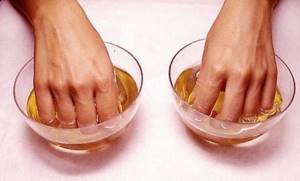
- Olive oil . You need to choose a cold-pressed product, heat it in a water bath and dip your fingertips in it. The procedure is performed every evening, the time of soaking the nails in the oil is 10 minutes.
Masks
Masks are especially effective if after a manicure with gel polish your nails begin to peel off. Experts recommend using:
- cosmetic clay 2 times a month - the raw material is diluted with warm water to a thick sour cream, applied to the nail plates in a thick layer and left for 20 minutes, after rinsing, a rich nourishing cream is applied;
- any sour berries (currants, cherries, sea buckthorn) - you need to grind them into puree and apply to the nail plates for 20 minutes, then rinse everything off and lubricate with a rich cream or natural cosmetic oil.
Nail mask with iodine Nourishing mask for nails and cuticles
You can quickly get rid of peeling nails using paraffin and gelatin. In the first case, you need to melt cosmetic paraffin in a water bath, immerse your hands in it for 10 minutes, and after removing, apply pharmaceutical vitamin E directly to the plates. This procedure can be performed daily before bed for 2-3 weeks.
Gelatin is used only 2 times a week - a bag of dry product (30 g) is dissolved according to the instructions in 250 ml of warm water, dip your fingers into the mixture for 15 minutes, after having previously lubricated the plates and the skin around them with a rich cream. After the specified time has passed, blot your fingers with a cloth.
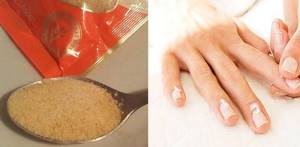
Proper care
Proper care of damaged nails after long-term use of gel polish is regular manicure. This implies a trimming version of the manipulation, short cutting of the nail, complete removal of the cuticle. If the nails are very flaky, then it is not advisable to use a file to correct the shape of the nail - it is better to use a soft buff, which is used without any effort and only on the end of the nail.
At the end of the manicure, you need to wipe the plate, cuticle, and surrounding skin with cosmetic oil. You should not apply decorative varnish to your nails, but using any pharmaceutical product with a restorative function will be useful.
Watch the video about proper nail care:
How to eliminate the negative effects of Shellac?
As you can see, rough nails after shellac removal (pictured) require especially careful care. Sometimes the base remains on the surface of the plates. It is not shiny because the sticky layer has been removed. However, this may cause some discomfort. If your nails hurt and strange white spots have formed, you should take advantage of the unique benefits of regular iodine. What is the appeal of this natural product? Iodine has a complex effect on the plates. The composition promotes:
- restoration of plates;
- their operational strengthening;
- structure regeneration;
- acquiring an attractive shade.
It is recommended to treat nails with a cotton swab previously soaked in iodine.
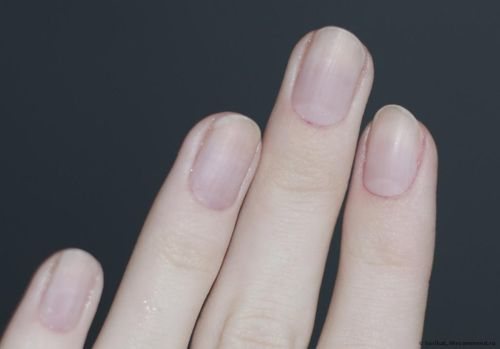
Nail treatment after gel polish in the salon
In the salon, nail treatment after gel polish is carried out by professionals, and they offer to restore the plates using the following procedures:
- Hot manicure with oil . Before the specialist begins to perform a classic manicure, he dips the client’s hands in a hot oil solution. Hypoallergenic products such as olive, peach, and almond oils are most often used - as independent products or a mixture of them. Such baths soften the skin and plates as much as possible, nourishing them with all the necessary elements.
- Japanese manicure . This procedure is aimed specifically at strengthening the nail, actively nourishing it and accelerating growth. The master must be a professional, because he will have to diagnose the condition of the nail plates, peel, bath, rub in special powder/paste/medicated oil/serum. Then a hand massage is performed.
- Lavender massage . This is the name of the manipulation, which combines peeling performed with lavender gel and sea salt. This “hard” massage ends with wrapping the hands in a warm towel, before applying a mint mask based on shea butter to the skin and nails. The cuticle must be strengthened with paraffin, and the nails are coated with a specific strengthening compound.
We recommend reading the article about what you need to know when choosing a lamp for gel polish. From it you will learn why you need a lamp for gel polish, how it works, and how to choose a lamp for drying gel polish. And here is more information about how to remove shellac at home.
Nail restoration after gel polish can be quick and long-lasting, carried out with home or professional remedies, sometimes full-fledged treatment is required. The specific choice of procedures is made by either a manicurist or a dermatologist. As a rule, complete restoration of damaged nails occurs in 2-3 months, but this moment is individual and depends on the degree and type of damage.
Restoration of injured nails
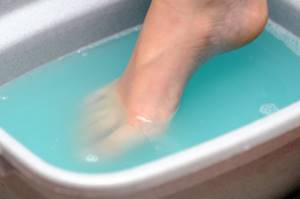
A bruise is often confused with a fungal infection due to changes in the structure and color of the tissue. The fact is that a severe injury can permanently deform the nail plate if proper restoration is not carried out. Mechanical injury rarely goes unnoticed due to its pain.
It is necessary to quickly cool the injury site. A crack or chip is disinfected with iodine. If a hematoma does form, it is removed by piercing the nail with a needle. Leaving the bruise unattended results in a lumpy nail plate.
Sometimes the cause of a nail injury is ill-fitting shoes. The most advanced injuries require surgical intervention with a protracted course of rehabilitation treatment.


